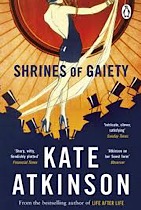 Ah how splendid Shrines of Gaiety is! Let us count the ways! Kate Atkinson’s latest novel is set in 1926, just shy of the General Strike. Nellie Coker, doyen of a half dozen night clubs across the capital (and a shoo-in for Kathy Burke if they ever make a film of this book, which they absolutely should), is just out of prison, and the local law enforcement is taking a keen interest in more ways than one.
Ah how splendid Shrines of Gaiety is! Let us count the ways! Kate Atkinson’s latest novel is set in 1926, just shy of the General Strike. Nellie Coker, doyen of a half dozen night clubs across the capital (and a shoo-in for Kathy Burke if they ever make a film of this book, which they absolutely should), is just out of prison, and the local law enforcement is taking a keen interest in more ways than one.
Firstly, you have Frobisher, a Prufrock-like copper, who has set himself up with a spy, a Miss Gwendolen Kelling, formerly a librarian but in London to track down a couple of missing girls, one of whom – Freda – ran away looking for fame and fortune as a dancing girl. Frobisher wants Kelling to infiltrate the Coker empire to see what she can turn up (the “you scratch my back…” element of it being that he will help her track down the missing girls).
You also have an Inspector Maddox, though, loitering in the background, a copper who is ringing in sick, who may be looking to change jobs, as it were, to ditch the copper’s life for a slice of Nellie’s proverbial pie, and he’s planning a coup, which Nellie is quickly aware of; and Maddox has co-opted a couple of other coppers who are themselves not the brightest of tools but who, nevertheless, involve themselves in intrigue and no good.
And we’ve not even got to Nellie’s progeny yet, all of Nellie’s many children – Niven, the dark horse, Edith, the most responsible and trusted, and then Betty and Shirley, flighty albeit capable sorts, and Ramsay, the would-be literary genius.
This is a world with a vibrant underworld colour to it:
“The London gangs who all streamed into the club from time to time treated it like a battlefield. The Elephant and Castle mob, Derby Sabini’s roughs, Monty Abrahams and his followers, the Hoxton gang. The Hackney Huns, the Frazzinis…”
As you might have gathered from the above, there are a fair few characters but, thanks to a combination of short chapters and the kind of Atkinsonian gusto with which she writes and which propels the reader through the book, you rarely find yourself scratching your head wondering who’s who. Whether it’s time spent in Gwendolen’s company or Frobisher or Nellie or Niven or Ramsay or Edith, the voices remain distinct and the intermingling narratives serve to ratchet up both the tension and the light-hearted comic pacing as the book races along (although it is worth saying, Atkinson is a dab hand at meting out the sort of rumbling cello-scored darkness that will have you worrying for poor Freda and her mate as young girls keep turning up having been battered and drowned in the Thames).
You may even find yourself wondering, as we did, if Atkinson has in fact created a new Jackson Brodie in the form of Gwendolen Kelling as we would dearly love to hear from her again. (Just about the only criticism we had was of the more overt lifting of the curtain towards the close of the book in which a newspaperboy appears – “Yes, the very same newspaper delivery boy that we met outside Holloway many chapters ago” – as it gives you a sort of readerly experience akin to emerging blinking from the cinema in the daytime to find it’s still light outside. But it’s a super small point and we enjoyed ourselves hugely with this.)
But all in all, it’s just enormous page turning fun, the kind of book as more-ish as a big bucket of popcorn. We wolfed it down and were left wanting…
Any Cop?: Quite simply: more please!